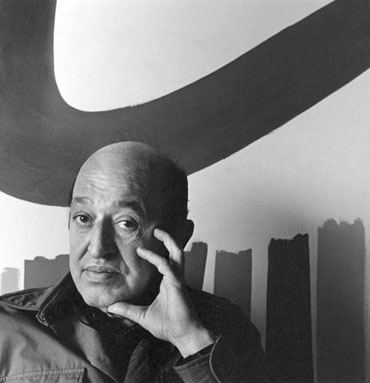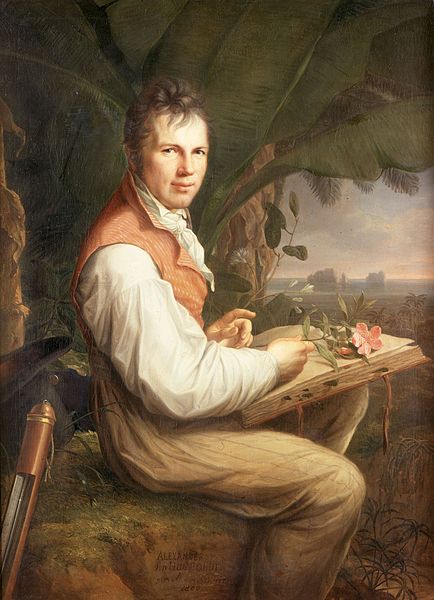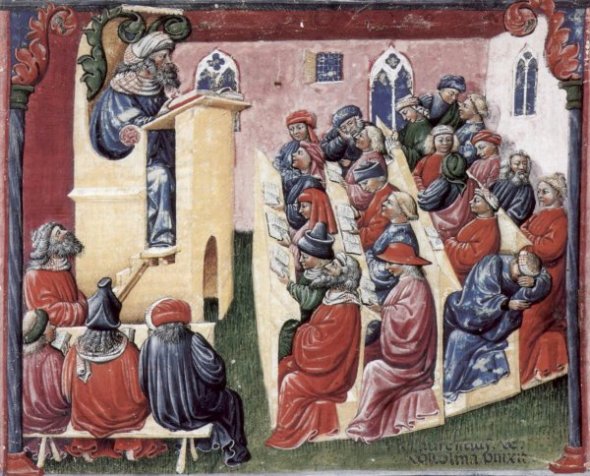The Art of the Exegesis
With art schools' integration into the university system, artists are required to present their work as written ‘exegesis’. Here, Danny Butt traces exegesis back to its origins as a form of knowledge production and considers its limiting effect on art’s own power of revelation
At the end of the 18th century, Nazarene painter Eberhard Wachter rejected a position on the staff of the Stuttgart academy, noting that ‘there is too much misery in art already; I do not want to increase it.’1 Wachter uttered his sullen epigram on art education well before the development of postgraduate programmes in studio art, but the weariness of his tone would have only increased if he had read the raft of ‘written components’ – usually in the form of an exegesis – that are now mandatory in art school submissions. Examiners do their best to maintain fresh eyes in front of works that groan under pointless descriptions of dull making processes, overblown and unconvincing attempts by artists to write their own work in an art historical tradition, or perhaps worst of all, interesting practices (de)formed into ‘research questions’ that the works are then supposed to answer. Duchamp did his best to dissuade such thinking, believing that ‘there is no solution, because there is no problem.’2 Now the need to find problems to satisfy a demand for academic rigour seems to be the problem.
These crimes of writing committed in art schools are not the fault of artists, who know all too well that a written exegesis usually hinders great work. Students often evade supervision of these research reports – perhaps hoping that the requirement might slip away unnoticed. Not because they can’t write: visual artists can be formally gifted and inventive writers. But contemporary artists are reflexive critics of form in the most expanded sense, often unhappy with any institutional dictation of form or genre from above. As Dieter Lesage has argued, to require an artist to adopt a particular form of writing is precisely to fail to recognise their status as an artist.3 Artists also seem to recognise that the university exegesis yields little aesthetic or professional reward: the market seeks the artist as a producer of mystery, rather than an explainer. Ironically, the exegesis often fails to record the student’s learning through their reading, writing and talking about ideas and theory of various kinds, because this learning is precisely useful when it operates behind the scenes of an artistic work, rather than in front of it. In Foucauldian terms, art points to the emergence and decline of stable discourses, zones where the seeable moves into or out of the realm of the sayable. If a concept can be captured clearly in academic writing as a question, what would be the point of making art with it? The exegesis seems to become a particularly useless form both in the university and in the art world, existing only to allow a bureaucratic calculation of the student’s acceptability for an awarded degree.
In traditional theological practice, the exegesis carried God’s word to the world, a mission reflected in the term’s Greek etymology (ex - outward; hegeisthai - to lead or guide). God’s final word could not be directly accessed by humans, and so biblical lessons required interpretation so they could be applied to everyday life. During the medieval birth of the university, the scholastic methods of disputation and interpretation developed this analytical method of the critic, eventually extending from the holy book to other works, including works of art. The small, fixed stock of artistic examples copied in the academy reflected God’s design for the world, and these also required interpretive commentary to reach an imperfect broader society. Interpretation in the critical tradition relies on dialogue and debate – even today it is not customary for a contemporary artist to secure the interpretation of their own work. Such attempts – increasingly demanded by research-minded institutions – not only seem a little naff, but also impose upon the freedom of appreciation that Kantian aestheticians have understood to be at the centre of the art experience. This is not to say that the artist lacks critical knowledge of their work, but theirs is merely the first in a chain of interpretations that run from artist, to curator, to audience and beyond. Once the work reaches a public, the correct interpretation can no longer be the artist’s property if the audience is to find their own experience of the work.

Image: Art critic Clement Greenberg
Science is the obvious culprit for the proprietisation and individualisation of interpretation in the university art school. In the modern universities from Berlin in 1810, science replaced theological scholasticism as the dominant European means of stabilising the natural world for analysis and calculation. Foucault described how the Renaissance era brought about the conditions for the spread of scientific thinking, where relations between name and order; how to discover a nomenclature that would be a taxonomy became the preoccupation of the day4. Access to truth was democratised, or more correctly transposed from the institution of the church to the bourgeois gentleman. Today, we think of science as opposed to religion, but Robert Merton showed that the transition from scientia as knowledge of God to scientia as knowledge of nature was not a revolutionary shift. Instead, under the Protestant ethic, scientific experimentation developed as a method for the pious discovery of God’s world, while nature’s religious underpinning moved from public to private language.5 In the 19th century, for example, it was impossible for the average scientist to suggest that scientific knowledge was incompatible with Christian thought. Natural philosophy was seen as a pious (if not religious) activity, proper for a gentleman precisely because it avoided the bitter arguments of scholasticism. Avoiding the interminable arguments about life and death, good and evil; the forward looking sciences bracketed such questions while pursuing ever more highly specialised modes of investigation, whose resulting knowledge of ‘what is’ would be held with the ‘expert’ individual.
As Haraway, Shapin and other historians of science have shown, the written account of experiments in the Republic of Letters became an exercise in the rhetoric of truth, which could be asserted by the writer without the transcendental-theoretical problems of theological argument.6 The scientific report would not be a set of instructions to be replicated or a set of arguments to be deconstructed, but a claim to significance by a ‘modest witness’, who must firmly position themselves in what Traweek calls a ‘culture of no culture.’7 Lorraine Daston describes this culture as reliant upon a moral economy of ‘gentlemanly honor, Protestant introspection, [and] bourgeois punctiliousness.’8 In this mode, the written report must be seen to ‘guarantee’ the validity and transferability of knowledge as a unit of truth. Ironically, this ‘transferability’ would be obtained through the suppression of both the written rhetorical skills of the creator and their tacit experimental knowledge. Science would philosophically appropriate writing as a supposedly neutral container for knowledge in general. To achieve credibility the scientist must suppress the subjective conditions of production to construct a blank neutral facticity, guarding against the dread errors of ‘idolatry, seduction, and projection’ that might compromise objectivity and breach decorum.9
Of course, the ‘errors’ of excessive belief and fantastic projection are precisely the mechanisms through which the Romantic artist would come to make their mark. Meanwhile, what Galison calls ‘conditions of possible comportment’ for the scientific researcher were emblematic of colonial patriarchy, with its well documented fears of the feminine body.10 In the 18th century, experimentalists became obsessed with development of ‘spiritual and bodily regimens [that should] be rigorously followed to rein in… dangerous inclinations.’11 Daston notes that the psychological and biophysical aspects of excessive belief were closely linked – the seductive lure of the imagination, in the eyes of the Cambridge philosopher More, could be avoided by steering clear of ‘hot and heightening meats and drinks’, by taking walks in the fresh air and by avoiding too much time in one’s own company.12 The scientific appropriation and regulation of the self takes on a moral flavour that is reflected today in science’s hierarchical modes of industrial organisation.
The modern avant-garde’s inventive and corrosive attacks on bourgeois morality were therefore not the kind of ‘creativity’ that led to their incorporation in to the research university. Bernard Darras describes the art education of the last two centuries as characterised by four competing philosophies of development: i) the patrimonials, seeking to uphold the great academic traditions; ii) the functionalists, seeking social and economic development through drawing; iii) the psychologists and educationalists, seeing art as a pathway to individual creative and cognitive development; and finally iv) the avant-garde, reflecting romantic modernist principles of aesthetic autonomy.13 Within the scientific university, the psychology influenced educationalists have generally had their hands closest to the rudder of curriculum, leading the development of ‘creative doctorates’ in US colleges of education throughout the 20th century, adapted from the emergent models of the social sciences. While many North American commentators today seek to defend the MFA against the incursion of UK-style studio art PhDs, it was actually the US creative doctorate that provided the model for the recoding of art as research in the UK universities during the 1980s and 1990s. These doctorates were supported in the mid-20th century by museum administrators such as MoMA’s Alfred Barr, who saw only positive things coming from the recognition of art as equivalent to scientific disciplines. The famous US educator Lester Longman, a notably conservative critic, wrote in 1946 that he wanted to develop
experimental work on a more advanced level so that we may contribute new ideas to the field of art as freely as New York or Paris… In the sciences it is generally expected that universities will be in the vanguard of experimentation. I want to be the first to do this in the field of art14.
Be careful what you wish for Lester! Instead of new laboratories to lead the arts, the incorporation of art into research degrees and science and technology policy funding has resulted in the hegemony of quasi-scientific modes of academic writing by art students. In this restricted vocabulary, artists are encouraged to stabilise their own work and explain its contribution in a highly unproductive ‘objective style’, reflecting the moral economies that have been the target of so many artistic movements. Artists are required to shut out the invitation to the critic, to secure the interpretation of their own work and justify its value. One is struck by the homologies with Foucault’s account of the stakes of neoliberalism, ‘the replacement every time of homo œconomicus as partner of exchange with a homo œconomicus as entrepreneur of himself, being for himself his own capital, being for himself his own producer, being for himself the source of [his] earnings.’15 The life of the producer of their own value is a lonely one.
If art offers anything to the university – which should be kept as an open question – it is perhaps located in its critical culture that deconstructs the self-authoring productive subject. The critic as interpreter – with the artist themselves being the first to adopt the role – plays a key role in the the work’s ethical character, where a work is understood to be more than a container for the intellectual property of its author. It is a heterogeneous social artefact that hovers ambivalently in the world, constructed of what Spivak describes as ‘figures, asking for dis-figuration’ in the meeting between work and viewer.16 This ambivalence brings into being space for the critical community which can allow the work to work; the social world where significance is debated and deliberated rather than protected by the individual and disseminated as an object. Any attempt to harness the criticality of the work in writing only paradoxically reduces its effectiveness as a work.

Image: Friedrich Georg Weitsch's portrait of Alexander von Humboldt, 1806
The research university has long been a holding company for a raft of disciplines that fight for their own autonomous development. PhD regulations say very little about how a student will undertake their research, because every field or specialism has its own way of doing things. Through historical circumstances at the birth of the PhD, the written thesis was the only technical form that could hold the triple functions of demonstrating the disciplinary knowledge gained by a student, disseminating it geographically and archiving it through time.17 With the library no longer being the ideal form of archive or distribution, these written forms of the thesis as the sole container for knowledge are under pressure, even in the scientific disciplines, where various forms of ‘knowledge transfer’ are increasingly prevalent. In this context, it is hard to see how art’s own disciplinary strength will be enhanced by adopting the quasi-scientific report over the characteristic forms of writing (or non-writing) that already operate in the visual art world. Rather than simply adapting to 19th century models of scientific knowledge production, contemporary art could allow us to rethink material genres of knowledge production and dissemination in the university.18 But the only way this can occur is if the most valuable customary forms of practice in the visual arts are developed as the basis of the discipline’s ‘contribution to knowledge’, which will first and foremost be a critical analysis of knowledge’s form. The vampiric form of the exegesis only suppresses art’s potential in the future university.
Danny Butt <http://www.dannybutt.net> has taught in art and design schools for 15 years, currently at the Elam School of Fine Arts at the University of Auckland, New Zealand. He is part of the Local Time collective and is currently working on a book on the art school in the research university
Footnotes
1 Quoted in Nikolaus Pevsner, Academies of Art, Past and Present, New York: Da Capo, 1973 [1940], p.200.
2 ‘The Iconoclastic Opinions of M. Marcel Duchamp Concerning Art in America’, Current Opinion 59 (November 1915), pp.346-347. While I don’t fully endorse Duchamp’s renunciation of responsibility for problems, it is a statement that captures something fundamental about the attitudes of the avant-garde. For a more responsible but still usefully unscientific epigram on the status of art as problem solving, I thank Ken Hay for pointing me to Frank Stella’s statement: ‘There are two problems in painting: one is to find out what a painting is and the other is to find out how to make a painting.’ In Robert Rosenblum, Frank Stella, Harmondsworth: Baltimore, 1971, p.57.
3 Dieter Lesage, ‘On Supplementality’, in Agonistic Academies, Jan Cools and Henk Slager (eds.), Brussels: Sint-Lukas Books, 2011. p.78. For a related argument on the auto-criticality of works using media theory, see Howard Slater, ‘Post-Media Operators: ‘Sovereign & Vague’ Datacide 7 (2000), http://datacide.c8.com/post-media-operators-’sovereign-vague’. The general lack of fit between the fine arts and research frameworks is discussed most extensively and entertainingly by Robert Nelson in his book The Jealousy of Ideas: Research Methods in the Creative Arts, London: Ellikon, 2009, http://bit.ly/yG6wlG
4 Michel Foucault, The Order of Things: An Archaeology of the Human Sciences. London and New York: Routledge, 2003 [1970]. p208
5 Robert Merton, ‘Science, Technology and Society in Seventeenth Century England’, Osiris no. 4, 1938, pp.360-632. See Also Steven Harris, ‘Jesuit Scientific Activity in the Overseas Missions, 1540-1773’, Isis 96, no. 1, 2005, pp.71-79.
6 See for example Donna Haraway, Modest_Witness@Second_Millennium.Femaleman_Meets_Oncomouse: Feminism and Technoscience, New York: Routledge, 1997; Steven Shapin, Understanding the Merton Thesis’, Isis 79, no. 4, 1988, pp.594-605; and Shapin, ‘A Scholar and a Gentleman’: The Problematic Identity of the Scientific Practitioner in Early Modern England’, History of Science 29, no. 85, 1991, pp.279-327.
7 Sharon Traweek, Beamtimes and Lifetimes: The World of High Energy Physicists, Cambridge, Mass.: Harvard University Press, 1988. p.162.
8 Lorraine Daston, ‘The Moral Economy of Science’, Osiris 10, 1995, 3-24. p.24.
9 Lorraine Daston, ‘Scientific Error and the Ethos of Belief’, Social Research 72, no. 1, 2005, pp.1-28.
10 Peter Galison, ‘Judgement against Objectivity’, in Picturing Science, Producing Art, Caroline A. Jones, Peter Galison & Amy Slaton (eds.), New York: Routledge, 1998, pp.327-359. Galison makes his most speculative and interesting argument along these lines in his essay ‘Objectivity is Romantic’, in The Humanities and the Sciences, Billy Frye (ed.), Philadelphia, PA: American Council of Learned Societies, 1999, pp.15-43.
11 Daston, ‘Scientific Error’, op. cit., p.2.
12 Ibid.
13 Darras is commenting on Mary Ann Stankiewicz, ‘Capitalizing Art Education: Mapping International Histories’, in International Handbook of Research in Arts Education, edited by Liora Bresler, 16,. Dordrecht: Springer Netherlands, 2007, pp.7-38.
14 Quoted in Howard Singerman, Art Subjects: Making Artists in the American University, Berkeley: University of California Press, 1999, p.208.
15 Michel Foucault, The Birth of Biopolitics: Lectures at the Collège De France, 1978-79, Michel Senellart and Graham Burchell (trans.), New York: Palgrave Macmillan, 2008. p.226.
16 Gayatri Chakravorty Spivak, ‘Ethics and Politics in Tagore, Coetzee, and Certain Scenes of Teaching’, Diacritics 32, no. 3, 2002, 17-31. p21. Irit Rogoff helpfully points to ‘singularisation’ as the ethical potential of the critical attitude in the academy. See Rogoff, ‘Practicing Research / Singularising Knowledge’, in Agonistic Academies (see n3), pp.69-74.
17 A seminar by Sally Jane Norman at the University of Auckland, ‘Art - Research - Values’, 6th March 2012, extended my understanding of this point.
18 To my knowledge this argument is first staged by Jacques Derrida in ‘The University without Condition’ in Without Alibi, Peggy Kamuf (trans.),Stanford: Stanford University Press, 2002. pp.202-37. I give a detailed reading of this piece in the essay ‘Neo-liberal and Future Universities’, written for the We are the University zine, published to accompany Nationwide Day of Student Action, University of Auckland, 26th September 2011, http://dannybutt.net/neo-liberal-and-future-univer...
Mute Books Orders
For Mute Books distribution contact Anagram Books
contact@anagrambooks.com
For online purchases visit anagrambooks.com







